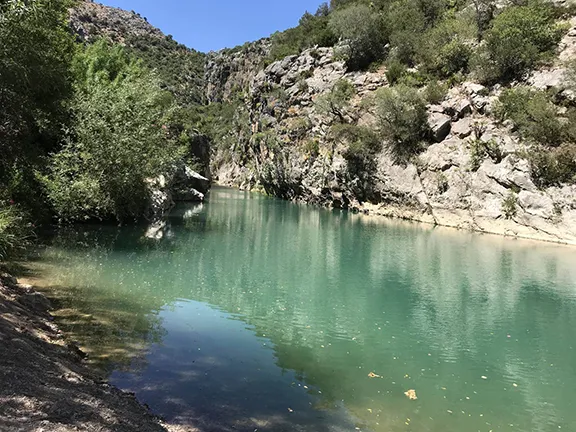El Colmenar or Estación de Gaucin, is a station on the Algeciras to Ronda railway line at the foot of the Buitreras Canyon
By Nick Nutter | Updated 4 Jun 2023 | Málaga | Villages |
Login to add to YOUR Favourites or Read Later


Level crossing at Colmenar
The village of El Colmenar is found nestled in one of the narrower Guadiaro river valleys and flanked on one side by the river and the other by the mighty Los Alcornocales Parque Natural (Natural Park). Although it is known as Estación de Gaucin, due to its station on the Algeciras to Ronda railway line, it is 11 kilometres from Gaucin and in a different municipality.


Estación de Gaucin
Around the village there exist traces that confirm that the valley was inhabited in the Roman era. However, it wasn’t until close to the end of the 19th century with the construction of the railway line that the dispersed population started to gather around the recently built railway station building, giving birth to the community now known as both El Colmenar and Estación de Gaucin.


Buitreras dam
The creation of the Hydroelectric plant gave the final push to the formation of this village, which became one of the most populated in the area. The village is seated within the municipality of Cortes de la Frontera. By road it is 140km to Malaga and 40km from the coast and is well connected by rail with four daily trains running to Algeciras and Ronda.


Buitreras Canyon
The history of El Colmenar is intimately associated with the Algeciras – Bobadilla train line. Many people still call the village Estación de Gaucin, but its original name was Estación del Molino Regolfo, one of the 22 stations which had been designed following the colonial style of the Imperial India Company. In 1865 it became necessary to connect the Campo de Gibraltar with the rest of Spain, giving way to the expansion of rail with the Algeciras – Bobadilla line. After much ado it was the British company ‘The Algeciras (Gibraltar) Railway Co. Ltd’ which won the concession in 1888 under the Scottish engineer John Morrison. The construction of the line was very arduous given the number of tunnels and bridges along the route. The first part installed between Algeciras and Jimena was inaugurated on the 6th Oct 1890, the second between Bobadilla and Ronda started functioning on the 7th Sept 1891. Finally, the part between Jimena and Ronda which was the most technically challenging entered into service on the 27th Nov 1892. The line serviced six daily passenger trains, and it was the four axel steam engines, built by Beyer Peacock in Manchester, that proved most reliable and remained in service until 1926.


Colmenar
The Buitreras Canyon declared a Natural Monument of Geological Character by the Junta de Andalucia is a narrow gorge 3km upriver from the Hydroelectric Plant. Its high vertical walls over 100 metres tall lead down to the winding course of the Guadiaro river – a haven for pot-holers, hikers and artists. At the mouth of the gorge the turquoise, emerald lagoon fed by an underground natural spring of invigoratingly cold water is an inviting sight after the 40-minute walk from the village. If you are brave enough to traverse the icy, even in mid-summer, water on the right side of the river just above the waterline, the rock face reveals a small brass plaque marking the underground cave and spring. High above the impressive Leonard Buzzards soar on the thermals to land in their nests high up in the rock face of the canyon. There are numerous natural swimming pools along the river including the popular beach located at the bottom of the village with a picturesque picnic area. Some popular activities in the area are mountain biking and rambling/hiking along the wide network of forestry tracks which criss-cross the Natural Park. One of the most famous routes is the one from El Colmenar to the cave of “Los Motillos” an important prehistoric archaeological site inhabited from Palaeolithic times. Very close to the cave are the “Pasadablanca Baths”, Roman sulphur baths and the remains of the Roman villa of Saeponia.
The village offers a fantastic range of restaurants at unbeatable prices, from local venison and wild boar at Restaurant Taberna de Flores to tapas and raciones on the terrace at Bar España - an ideal spot to sit and watch village life. Rincon del Cani, tucked behind Tabrerna Flores offers traditional and imaginative cuisine while vegetarian and ecological fare can be found at the idyllic Centro Ahora.
In the summer evenings after a tasty meal a copita or two can be sipped on the actual station platform provided by the Cantina Bar. There are also varied options for accommodation in the village and surrounding area with the rural Hotel Buitreras on the edge of the village backing onto the forest. Just outside the village, the upmarket Hacienda La Herriza has prime views over the valley while some local apartments, casitas and rural studios are hidden gems. Additionally the riverside Casa Ahora offers alternative holistic retreats with massages, sauna, Turkish bath and additional therapies.